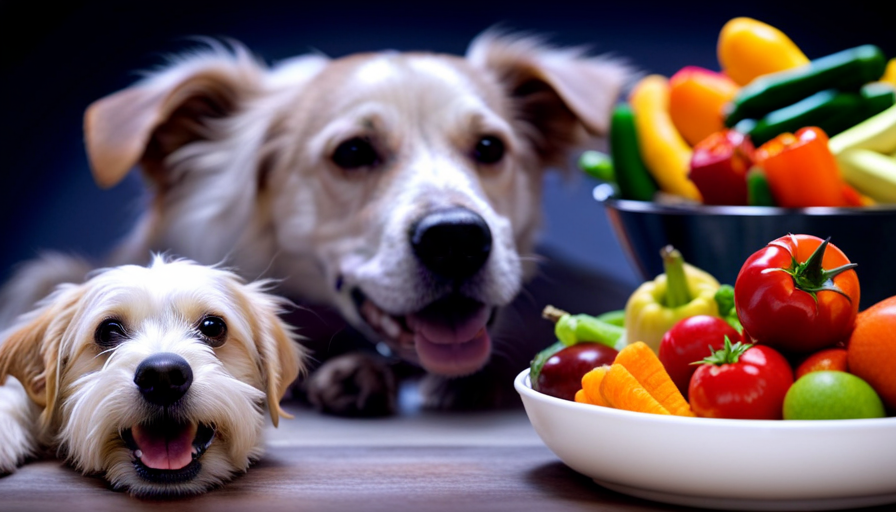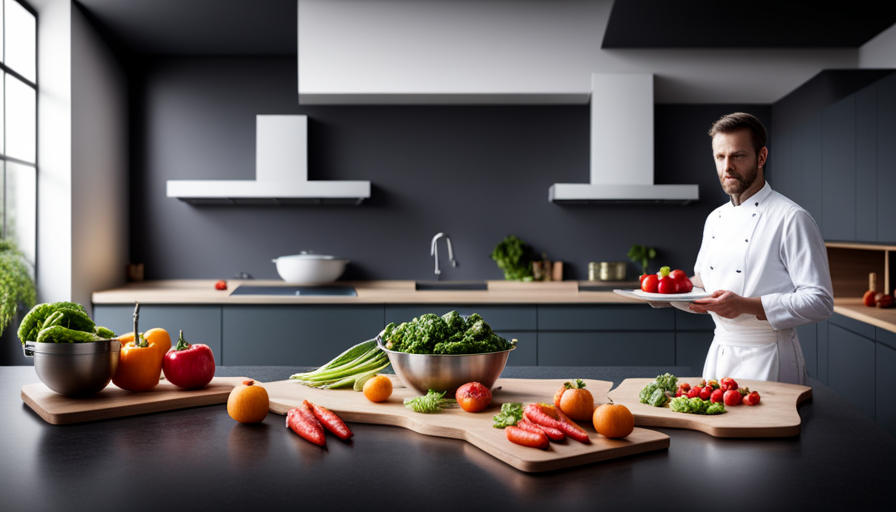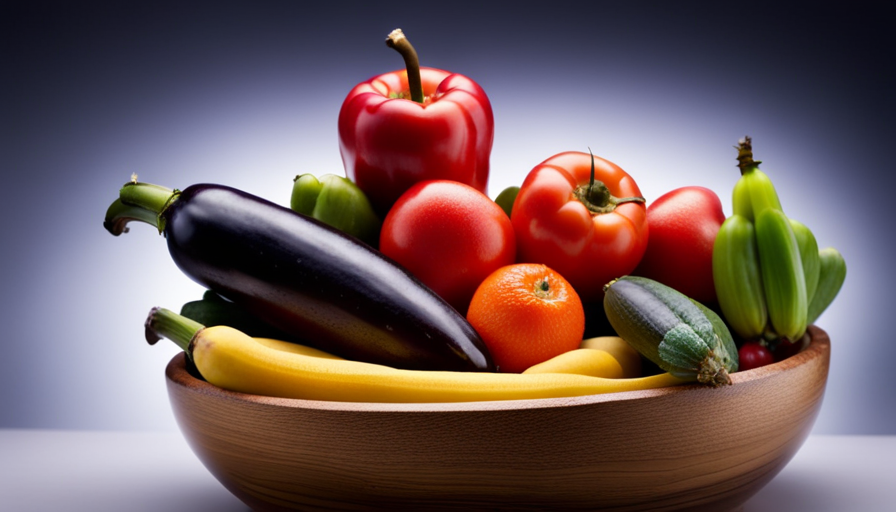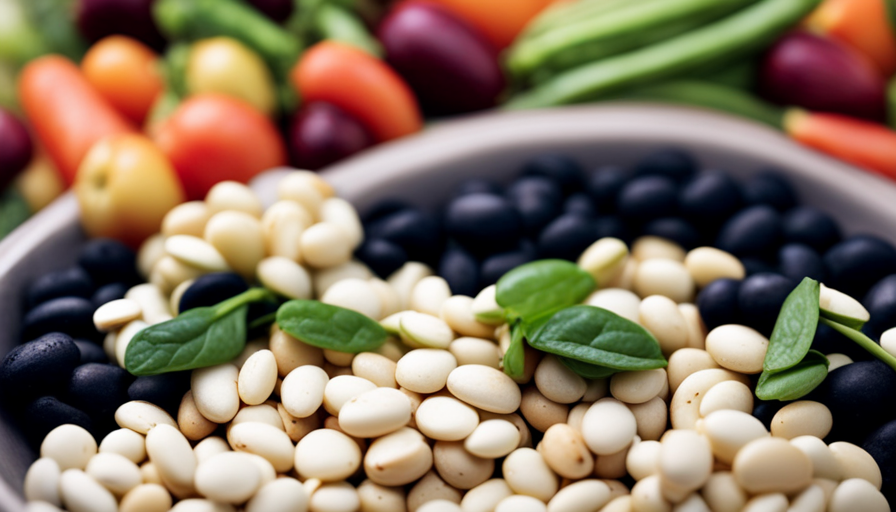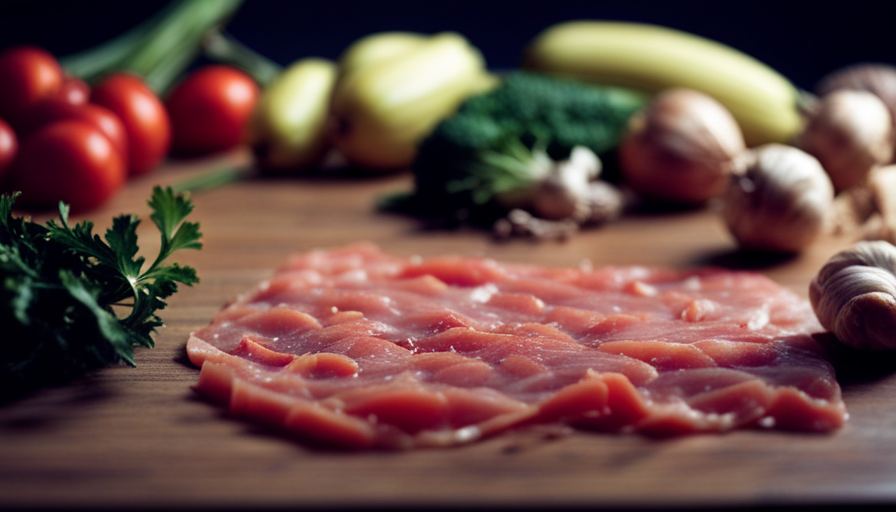I understand your concerns about feeding raw food to dogs. It’s natural to worry about the potential dangers. But let me assure you that adding raw food to your pet’s diet can greatly enhance their health and vitality.
In this article, I will guide you through the process of safely transitioning your dog to a raw food diet. From understanding the benefits of raw food to practicing safe food handling, we will cover everything you need to know to make this shift a success.
But before we dive in, it’s important to consult with your veterinarian. They will provide invaluable advice tailored specifically to your dog’s needs. With their guidance, you can start by introducing small amounts of raw food and gradually increase the portions over time. Monitoring your dog’s health and digestion throughout the process is crucial, as it allows you to make adjustments and ensure a smooth transition.
Remember, variety is key! Introducing a wide range of raw foods will provide your dog with a balanced diet, full of essential nutrients. And if you’re worried about the hassle of preparing raw meals, don’t fret. There are pre-made options available that meet all the nutritional requirements.
So, let’s embark on this journey together, with patience and flexibility. Your dog’s health and happiness are worth every effort.
Let’s get started on introducing raw food to your beloved pet!
Key Takeaways
- Consult with a veterinarian before transitioning to a raw food diet for your dog
- Start with small amounts of raw food and gradually increase the quantity
- Include a variety of proteins, fruits, vegetables, and leafy greens for a balanced diet
- Practice safe food handling and storage to minimize contamination risks
Understand the Benefits of a Raw Food Diet for Dogs
If you’re looking for a natural and nutritious way to boost your furry friend’s health, then you’ll be amazed at the benefits of a raw food diet for dogs. The raw food diet is based on the principle that dogs are carnivores and thrive on a diet that resembles what their ancestors ate in the wild. By feeding them raw food, you can provide them with a plethora of benefits.
One of the major benefits of a raw food diet is improved digestion. Raw food contains natural enzymes that aid in the digestion process, making it easier for your dog to absorb nutrients from their food. Additionally, raw food is free from fillers, additives, and preservatives that can cause allergies and digestive issues in dogs.
Another benefit is increased energy and vitality. When dogs consume a raw food diet, their bodies can efficiently utilize the nutrients, resulting in improved energy levels and overall vitality. This can be especially beneficial for active dogs or those recovering from an illness or surgery.
Furthermore, a raw food diet can lead to healthier skin and coat. The natural oils present in raw food promote a shiny coat and can help alleviate common skin issues such as dryness and itchiness.
Incorporating raw food into your dog’s diet can provide numerous benefits for their overall health and well-being. However, it’s important to consult with your veterinarian before making any dietary changes for your furry friend. They can provide guidance and ensure that the raw food diet is suitable for your dog’s specific needs and health conditions.
Consult with Your Veterinarian
Before embarking on this new culinary journey for your furry friend, it’s crucial to consult with your trusted veterinarian. They can serve as your guiding compass on this raw food adventure. Your veterinarian will have a deep understanding of your dog’s specific health needs and can provide valuable insights on whether a raw food diet is suitable.
They can also help address any concerns or potential risks associated with this type of diet. When discussing the potential risks of a raw food diet for dogs, your veterinarian may mention the risk of bacterial contamination, such as salmonella or E. coli. They can inform you about proper handling and storage practices to minimize these risks. Additionally, they can discuss the importance of a balanced diet and potential nutrient deficiencies that may arise if not properly addressed.
Common misconceptions about raw food diets for dogs may also be addressed by your veterinarian. They can debunk myths such as the belief that a raw food diet will automatically improve a dog’s coat or reduce allergies. They can provide evidence-based information to help you make an informed decision.
By consulting with your veterinarian, you can ensure that you have all the necessary information to make the best choices for your dog’s health and well-being. Transitioning to a raw food diet can be a gradual process, starting with small amounts of raw food, as discussed in the subsequent section.
Start with Small Amounts of Raw Food
To truly nourish your furry companion, take the first step by gradually incorporating small portions of this fresh, natural diet into their meals.
There are several benefits of raw food for dogs, including improved digestion, healthier skin and coat, increased energy levels, and stronger immune systems. However, transitioning to a raw food diet for dogs should be done carefully to avoid any digestive issues or nutrient imbalances.
To start, begin by replacing a small portion of your dog’s regular food with raw food. You can mix it in or serve it separately, depending on your dog’s preferences. Monitor their reactions closely, looking for any signs of upset stomach or allergies. If everything goes well, gradually increase the amount of raw food over a period of weeks.
During this transition, it’s important to remember a few tips. First, make sure to source high-quality, human-grade raw food that’s specifically formulated for dogs. Second, include a variety of proteins, such as beef, chicken, and fish, to ensure a balanced diet. Finally, consult with your veterinarian to ensure that your dog’s getting all the necessary nutrients.
By starting with small amounts of raw food and following these tips, you can successfully introduce this beneficial diet to your dog. Now, let’s explore how to gradually increase the amount of raw food in their meals.
Gradually Increase the Amount of Raw Food
As you continue on this journey of nourishing your furry companion, you’ll gradually add more of the fresh, natural diet into their meals, allowing their health and vitality to flourish.
The transition process of introducing raw food to your dog should be done gradually to ensure a smooth adjustment. Start by increasing the amount of raw food by about 10% every week. This slow and steady approach will give your dog’s digestive system time to adapt to the new diet.
During this transition, closely monitor your dog’s health and digestion. Keep an eye out for any changes in their appetite, energy levels, or bowel movements. If you notice any issues, such as diarrhea or vomiting, it may be a sign that you need to slow down the transition process or make adjustments to the raw food you’re feeding.
Remember, every dog is different, and their response to raw food may vary. Some dogs may transition seamlessly, while others may require a more gradual increase in the amount of raw food. Pay attention to your dog’s individual needs and make adjustments accordingly.
By gradually increasing the amount of raw food in your dog’s diet, you’ll be ensuring a smooth transition and giving your furry friend the best chance at thriving on their new, natural diet. So let’s move on to the next step and explore how to monitor your dog’s health and digestion.
Monitor Your Dog’s Health and Digestion
Keep a close eye on your furry companion’s overall well-being and digestion to ensure that their transition to a fresh, natural diet is successful. When introducing raw food to your dog, it’s important to monitor their health and digestion to address any potential issues that may arise. One key aspect to watch is your dog’s weight. Raw food can be higher in calories than processed kibble, so it’s crucial to adjust the portion sizes accordingly. If your dog starts gaining too much weight, you can gradually reduce the amount of food you give them. On the other hand, if they lose weight, you may need to increase the portion size. Additionally, it’s important to be aware of any potential allergies your dog may have. Some dogs may be sensitive to certain proteins or ingredients in raw food. Watch for signs of itching, skin irritation, or digestive upset. If you notice any of these symptoms, consult with your veterinarian to determine the best course of action. Keeping a close watch on your dog’s health and digestion will help ensure a smooth transition to a raw food diet. As you continue on this journey, the next step is to balance the nutrients in your dog’s diet.
Balance the Nutrients in Your Dog’s Diet
Achieving a well-rounded canine diet is like creating a harmonious symphony of nutrients. To balance the nutritional requirements in your dog’s diet, it’s important to consider the nutrients they need and the sources from which they can obtain them.
When preparing homemade dog food, it’s crucial to include a variety of ingredients to ensure your furry friend gets all the essential nutrients. Here are two sub-lists that’ll help you balance the nutrients in your dog’s diet:
-
Protein Sources:
- Lean meats like chicken, turkey, and beef are excellent sources of protein.
- Fish, such as salmon or sardines, provide omega-3 fatty acids that promote a healthy coat and skin.
-
Fruits and Vegetables:
- Incorporate a mix of fruits and vegetables like carrots, apples, and spinach for added vitamins and minerals.
- Include leafy greens such as kale or broccoli, which are rich in antioxidants and fiber.
By incorporating these components into your dog’s diet, you can ensure their nutritional needs are met.
Transitioning into the subsequent section about introducing a variety of raw foods, it’s important to consider the specific benefits that different raw ingredients can offer.
Introduce a Variety of Raw Foods
Transitioning to a balanced raw food diet for your dog requires careful planning and consideration of their nutritional needs. In the previous subtopic, we discussed the importance of balancing the nutrients in your dog’s diet. Now, let’s talk about the next step in introducing raw food to your furry friend – incorporating a variety of raw foods.
When transitioning to a raw food diet, it is crucial to introduce new proteins gradually. Start by including a protein source that your dog is already familiar with, such as chicken or beef, and gradually introduce new proteins like lamb, turkey, or fish. This will help prevent any digestive issues and allow your dog’s system to adapt to different protein sources.
Additionally, it is essential to transition your dog to consuming bones as part of their raw food diet. Start with softer bones, such as chicken or turkey necks, and gradually introduce larger and denser bones like beef or pork bones. This will help strengthen your dog’s jaw muscles and provide them with the necessary nutrients found in bones.
To provide a comprehensive overview, here is a table showcasing different protein sources and bone options to incorporate into your dog’s raw food diet:
| Protein Sources | Bone Options |
|---|---|
| Chicken | Chicken necks |
| Beef | Beef bones |
| Lamb | Pork bones |
| Turkey | Turkey necks |
| Fish | Fish bones |
In the next section, we will discuss the importance of practicing safe food handling when preparing raw meals for your dog. It is crucial to ensure the safety of both your dog and yourself.
Practice Safe Food Handling
When it comes to incorporating a variety of raw foods into your furry friend’s diet, it’s important to prioritize practicing safe food handling to ensure the well-being of both you and your canine companion.
Safe food storage is crucial to prevent the growth of harmful bacteria and keep the raw food fresh. Make sure to store raw meats separately from other foods in the refrigerator to avoid cross-contamination. Use airtight containers or freezer bags to seal the raw food properly. Additionally, always thaw the raw food in the refrigerator to maintain its quality and prevent the growth of bacteria.
Proper food preparation is another key aspect of safe food handling. Wash your hands thoroughly with soap and water before and after handling raw food to minimize the risk of spreading bacteria. Clean and sanitize all surfaces and utensils that come into contact with raw food to prevent cross-contamination. It’s also essential to feed your dog the raw food within a reasonable time frame to avoid spoilage.
Considering pre-made raw food options can be a convenient and safe alternative. These commercially prepared raw diets undergo strict quality control measures and are formulated to provide balanced nutrition for your furry friend. Transitioning to pre-made raw food can be a smooth and hassle-free process for both you and your dog.
Now, let’s delve into the next step: considering pre-made raw food options.
Consider Pre-Made Raw Food Options
If you’re looking for a convenient and hassle-free way to provide balanced nutrition for your furry friend, consider exploring the world of pre-made raw food options.
Pre-made raw food options are a great alternative to homemade raw diets, as they save you time and effort in sourcing and preparing the ingredients. These pre-made options are specifically formulated to provide the necessary nutrients for your dog’s overall health and well-being.
One of the main benefits of pre-made raw food options is that they’re balanced and complete, ensuring that your dog receives all the essential nutrients they need. These options often include a variety of proteins, such as beef, chicken, and fish, which helps to provide a well-rounded diet. Additionally, they may also contain fruits, vegetables, and supplements to ensure your dog receives a balanced and nutritious meal.
When selecting pre-made raw food options, it’s important to choose reputable brands that prioritize quality and safety. Look for products that are made with human-grade ingredients and undergo rigorous testing to ensure they’re free from contaminants.
By incorporating pre-made raw food options into your dog’s diet, you can provide them with the benefits of a raw food diet without the hassle of sourcing and preparing the ingredients yourself. So, be patient and flexible with the transition process, as it may take time for your dog to adjust to the new diet and find their favorite flavors.
Be Patient and Flexible with the Transition Process
Remember to have patience and be open-minded during the process of transitioning your furry friend to a new and exciting diet. Switching from traditional kibble to a raw food diet can be a bit challenging for both you and your dog, but with the right approach, it can be a smooth and successful transition. Here are three important things to keep in mind:
-
Gradual Transition: It’s essential to introduce raw food slowly and gradually. Start by mixing a small amount of raw food with your dog’s regular diet and gradually increase the proportion over time. This allows their digestive system to adjust to the new diet without causing any discomfort or digestive issues.
-
Monitor Their Response: Pay close attention to how your dog responds to the transition. Some dogs may experience loose stools or an upset stomach initially. If this happens, consider slowing down the transition process or consulting with a veterinarian for advice. Every dog is unique, and their bodies may need more time to adapt.
-
Explore Alternative Diets: While raw food is a popular choice, it’s essential to consider alternative diets as well. Some dogs may have specific dietary requirements or sensitivities that make raw food challenging. It’s always a good idea to consult with a veterinarian or a professional pet nutritionist to explore other options that may better suit your dog’s needs.
By being patient, flexible, and attentive to your dog’s needs, you can successfully transition them to a raw food diet and provide them with a healthier and more natural way of eating.
Frequently Asked Questions
Can I feed my dog exclusively raw food or should I still include some commercial dog food in their diet?
Feeding your dog exclusively raw food can be a healthy choice, as it provides numerous benefits. According to a study by the American Veterinary Medical Association, dogs on a raw food diet have lower instances of obesity and allergies.
However, it’s important to be aware of the pros and cons of both raw food and commercial dog food. Raw food offers natural ingredients and nutrients, but it requires careful balance and preparation. Transitioning your dog to a raw food diet should be done gradually to avoid digestive issues.
Are there any specific raw food ingredients that are not safe for dogs to consume?
When it comes to feeding raw food to dogs, it’s important to be aware of potential dangers. Raw chicken, in particular, can pose risks such as bacterial contamination, including salmonella and campylobacter. These can lead to food poisoning and other health issues in dogs. That’s why consulting a veterinarian before starting a raw food diet is crucial. They can provide guidance on safe raw food ingredients and help ensure your dog’s nutritional needs are properly met.
How long should I wait before introducing a new type of raw food to my dog?
When it comes to introducing a new type of raw food to your dog, it’s important to wait for the right time. I typically recommend waiting at least a week before introducing a new ingredient.
This waiting period allows your dog’s digestive system to adjust and helps prevent any potential digestive upset. A raw food diet can offer numerous benefits for dogs, such as improved digestion, a healthier coat, and increased energy levels.
So, take your time and gradually introduce new foods to ensure a smooth transition for your furry friend.
What are the potential risks or side effects of transitioning my dog to a raw food diet?
The potential risks of feeding raw food to dogs include bacterial contamination, such as Salmonella or E. coli, which can lead to illness in both dogs and humans. Other risks involve an unbalanced diet, as raw food diets may lack essential nutrients like calcium or vitamins.
Potential side effects of a raw food diet in dogs can include gastrointestinal upset, such as diarrhea or vomiting.
It’s important to consult with a veterinarian before transitioning your dog to a raw food diet to ensure their health and safety.
Can I feed my dog raw bones as part of their raw food diet?
Raw bones can be a beneficial addition to a dog’s raw food diet. They provide various health benefits, such as improving dental health and strengthening jaw muscles. Raw bones are a natural source of essential nutrients and can help satisfy a dog’s instinct to chew. However, it’s important to choose appropriate bones for your dog’s size and breed, as some bones can splinter and cause harm. Always supervise your dog when they’re enjoying a raw bone to ensure their safety.
Can I Use the Same Raw Food Preparation Method When Introducing Raw Food to My Dog?
When introducing raw food to your dog, it’s important to use safe raw food meal preparation techniques. It’s recommended to consult with a veterinarian for the best approach. Keep in mind that dogs have different dietary needs than humans, so it’s essential to do thorough research before starting.
Is it Safe to Feed Raw Meat to Dogs?
When it comes to reporting raw meat pet food sales, it’s important to consider the safety of feeding raw meat to dogs. While some advocates claim it’s natural and beneficial, others argue it poses health risks such as bacterial contamination and nutritional imbalances. Consulting a vet is wise before making any decisions.
Conclusion
In conclusion, introducing raw food to your dog can be a beneficial and healthy choice. It’s important to consult with your veterinarian and start with small amounts, gradually increasing the quantity over time.
Monitor your dog’s health and digestion closely, and introduce a variety of raw food options to keep their diet balanced. Practice safe food handling and consider pre-made raw food options for convenience.
Remember, Rome wasn’t built in a day, so be patient and flexible during the transition process. Your furry friend will thank you for it!

